Do you want to know more about the Germanic Europe DNA ethnicity on Ancestry? You've come to the right place. You are also in excellent company!
Many tens of millions of Americans have ancestry in the part of Europe covered by the Germanic Europe DNA ethnicity. For example, more than 44 million people living in the United States identify as having ancestors from Germany, one of the main countries in the Germanic Europe DNA region.
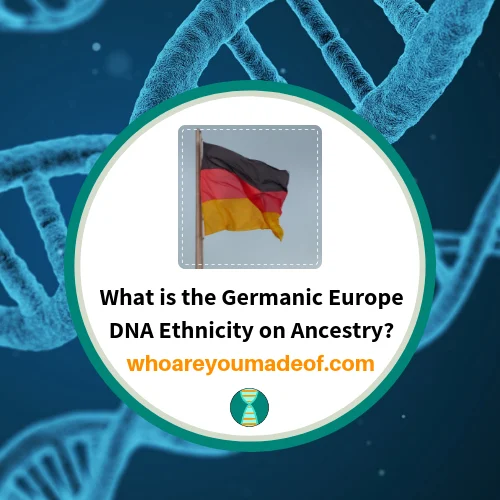
If we count people with Germanic ancestry through one of the many other countries where you could find Germanic Europe DNA, the number could certainly be tens of millions more.
In this post, you'll learn:
- Where the Germanic Europe DNA ethnicity is located
- Which countries are generally considered part of the Germanic Europe DNA region
- How Germanic Europe DNA came to exist
- Whether you can find Germanic Europe DNA in other parts of Europe
- Suggestions for how you inherited your Germanic Europe DNA
- How to research your Germanic Europe ancestors
If you tested with Ancestry DNA before the summer of 2018 may have noticed that your ethnicity results have gone through significant updates since that time. Ancestry DNA does periodically update ethnicity results based on new science and technological advances, so we might see our results adjusted periodically.
It is one of the biggest reasons to periodically check back with your Ancestry DNA results, as they become more accurate each year. The biggest change that you might have seen that is relevant to this post that the Europe West DNA region was renamed as Germanic Europe to better match the more refined geographic region.
Check out my DNA tools page where you can find links to dozens of articles that can help you learn more from your DNA results, build your family tree, and more!
Where is the Germanic Europe DNA Ethnicity located?
The Germanic Europe DNA region is located in the most northwestern part of Western Europe and is adjacent to Eastern Europe and Russia, a distinct DNA region. Germanic Europe is bordered by France to the west, Sweden to the north, Poland and Slovakia to the east, and Croatia and Italy to the south.
For those who prefer to visualize the location of the region on the map in order to better understand where Germanic Europe is, you can see the approximate region covered by the Germanic Europe DNA ethnicity within the red oval in the map below:
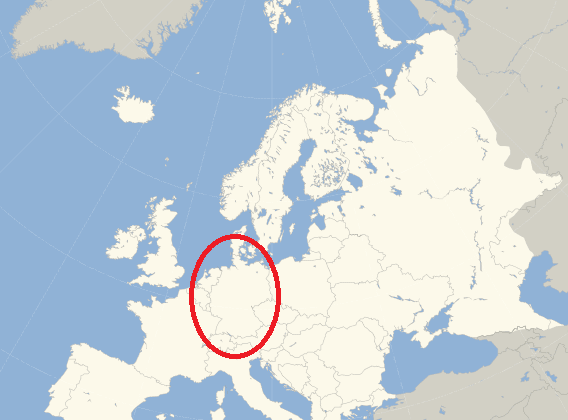
Blank_map_of_Europe_(polar_stereographic_projection)_cropped.svg: Ssolbergjderivative work: Dbachmann (talk) - CC BY-SA 3.0,
Directly to the north of the Germanic Europe region on Ancestry DNA, we find the North Sea and the Baltic Sea. These bodies of water serve as a northern boundary for this region, but we often do find genetic connections between countries like Denmark and even the UK, to countries in the Germanic region.
After all, our ancestors did take to the sea as often as they could in order to find food and economic opportunities.
In which countries can you find Germanic Europe DNA?
Upon reading the term "Germanic Europe", you might be tempted to associate it with the country Germany. While Germany is within the Germanic Europe DNA region, the region also encompasses a few other entire countries and portions of several others.
You can find Germanic Europe DNA in Germany, as well as many of the surrounding areas.
While Germany certainly derives its name from the word "Germanic", many countries in Europe have roots with the Germanic tribes that settled in Central and Western Europe at least 1500 years ago. The name "Germanic" is of Latin origin, and was given to the vast, culturally and linguistically diverse collection of tribes with a common origin, by the Romans.
What are the Germanic Europe countries?
As I mentioned, you'll definitely find Germanic Europe DNA in Germany, but you can also find it in the following Germanic Europe countries:
- The Netherlands
- Poland
- Belgium
- Switzerland
- Austria
- Czech Republic (primarily in Western Czech Republic)
- Denmark
- Slovakia
- Hungary
- Slovenia
- France
People who have extensive family history in the Germanic Europe region generally show a high percentage of their DNA (as high as 75%) as matching the area. It is very common for people from the Germanic Europe region to have some DNA matching neighboring regions, such as Eastern Europe and Russia.
So What is Germanic Europe DNA?
When wondering about Germanic Europe DNA, you might be curious to learn what Germanic Europe is. How did Germanic Europe become what is it today, and how has it influenced the DNA of the region?
The genetic makeup of Germanic Europe has been impacted by many conflicts, migrations, invasions, and domination by foreign powers. In addition, physical boundaries such as mountain ranges and oceans have played a role in developing the cultural identity of Germanic Europe.
What does Germanic Europe mean?
It is important to note that Germanic Europe is not the same as German, or Germany, which is a separate country in Europe. As you read above, Germany is just one country included within the Germanic Europe region.
However, each individual country within Germanic Europe, while sharing some common origins, has unique linguistic and cultural traditions. Even though there are many differences between Germanic European countries, it is helpful to understand a bit about their common origins.
Several books could be written on this topic, but I have selected a few key points in history to discuss that should help you understand the genetic origins of the Germanic European people.
First residents of Germanic Europe: Celtics and Germanic Tribes contribute to DNA of Germanic region
The first "modern" humans who moved into the Germanic Europe area were the Celts. They were living in this area at least 2600 years ago, which usually comes as a shock to most people.
I know that when I think of the Celtic tribes, my mind immediately goes to Ireland and Scotland, but evidence shows us that Celtic groups actually lived in Western Europe for a long time period. In fact, they lived in Western Europe before they migrated to the British Isles.
The areas in Western Europe where they lived before moving further west to Scotland and Ireland includes the area comprising the Germanic Europe DNA ethnicity region.
Celtic groups were organized, advanced societies - at least more advanced than most people give them credit for. Wealthy members of certain Celtic groups in Germany, for example, wore gold jewelry and imported exotic Spanish wines.
When we think of the Germanic Europe DNA region, our minds must first go to the Celts, the ancient inhabitants of the area. There are certainly genetic traces of these peoples, our ancient ancestors, in modern Germanic peoples.
It is believed that pressure from northern Germanic tribes and the southern Roman Empire led the Celtic tribes to leave this part of Western Europe.
Is there Roman DNA in Germanic Europe?
Up until about 1600 years ago, the Roman Empire was a powerhouse in Western Europe. Germanic tribes prevented the empire from expanding further north and east, but this resulted in Western Europe basically being split down the middle.
Peace along the territorial borders was rare, and we can only attempt to imagine the suffering that the average citizen endured during this time period. The Roman Empire disbanded in the year 400 A.D., possibly leaving a power vacuum leading to an intense period of conflict and migration.
The European Migration Period "Völkerwanderung" and Germanic DNA
For about 400 years during the Dark Ages (experts can't agree on the exact dates or time-frame), there was extensive migration all around the entire continent of Europe. This period was a key event in the formation of the Germanic Europe DNA region.
As the Roman Empire lost control of what we know to be the Germanic Europe DNA region, other tribes seized the opportunity for violent conflict to get new territories
The migrations can be attributed to conflict with tribes from Asia and other parts of Europe, including the Huns, Goths, Vandals, Slavs, Bulgars, and Alans.
For reasons too extensive to discuss with limited time and space, the Germanic Tribes, originally from Scandinavia, were the most successful in establishing themselves as permanent residents of what is now German-speaking Europe and the rest of the Germanic Europe DNA region.
The Franks - the rise of Germanic Europe
As I mentioned before, the Germanic Tribes did an excellent job of reducing the influence of the Roman Empire and establishing themselves as the new rulers. Groups of Germanic tribes united to become the Frankish Empire (also known as the Kingdom of the Franks).
The territory of this empire might sound very familiar to those interested in the DNA of the region. All of Germany, much of France, Northern Italy, as well as the Netherlands and Austria, were all parts of the Frankish Empire.
In the image below, you can see how the Frankish Empire grew in size and influence over the centuries. It's interesting to see how the initial sphere of influence very closely matches the genetic footprint of Germanic Europe:
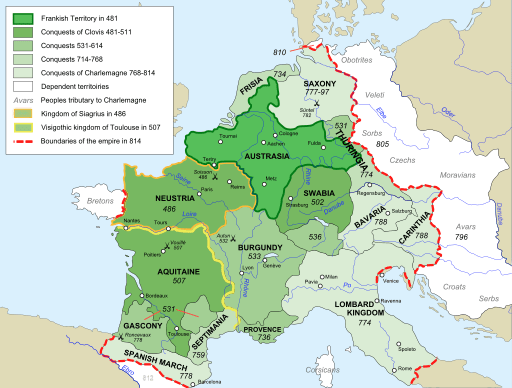
Is there Germanic Europe DNA in other parts of Europe?
It is very common for people who are native to one region to have at least some DNA in common with neighboring regions. This is especially common in Europe and other parts of the world where you don't need to travel by boat or move long distances to reach other groups of people.
This means that people who live in Germanic Europe might show DNA from Eastern Europe and Russia, France, England, Wales, and Northwestern Europe, or even Italy.
The exact makeup of one's DNA will depend on unique family history, so you'll have to do thorough research on your particular Germanic Europe ancestor to determine exactly where they lived and who people in their region historically had contact with.
How did I get Germanic Europe in my DNA Results?
Were you surprised to see Germanic Europe show up in your DNA results? Are you trying to figure out how the world you got your Germanic Europe DNA?
One of the first things that you should do when exploring your Germanic Europe DNA is click on the Germanic Europe region in your Ancestry DNA ethnicity estimate. You will be able to see the range of your DNA that matches this region - it will look something like the image below:
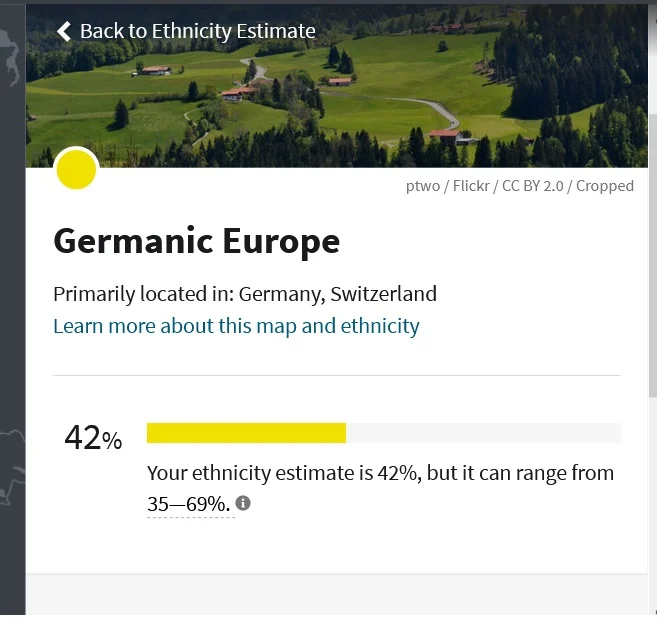
If you have a small percentage of Germanic Europe DNA, or if your range includes 0%, then there is always the possibility that your ancestors are from a neighboring region. This is something to consider especially if you were surprised to find this region in your ethnicity estimate.
The science of ethnicity estimates is still developing, which means we should always interpret our results as just that: an estimate. We are most likely to see our DNA matching "incorrect" regions when our ancestors are from an adjacent area, since everyone within the broader region has more genetic similarities than differences, thus making the tiniest differences in DNA markers difficult to distinguish.
However, there are cases where you can be almost absolutely certain that your Germanic Europe DNA results are "correct". This is especially true when you have received a specific sub-region or migration connected to Germanic Europe on your results.
If you got assigned one of the 24 Germanic Europe sub-regions or migrations, you can feel confident that you have ancestry from the area indicated on the map of the sub-region. These are rarely assigned in error, and so they can be very helpful in showing us where we might need to look to learn more about our ancestors.
Germanic Sub-regions can give information about how you got your Germanic Europe DNA
Some of you might have noticed on your Ancestry DNA ethnicity estimate that along with the Germanic Europe DNA ethnicity, you were also assigned a Germanic Europe sub-region.
Because of extensive German immigration to the US, Ancestry DNA was able to identify links between many users' DNA and specific migrations that took place from Germany to specific states within the US.
It makes sense that first-generation immigrants used to, and often still do, live together in communities where shared language and culture can assist them collectively in establishing themselves in their new country. The second and third generation descendants of these immigrants are more likely to move away from these population centers and establish their families on other areas.
This historic trend made it possible for Ancestry DNA to develop a feature (like the 24 currently available sub-regions within Germanic Europe) to help us learn more about where our ancestors may have lived.
If Ancestry DNA was able to detect a link to one of the sub-regions with a clear connection to a region within the US, it will be reported on your results underneath the main "Germanic Europe" regional heading.
The currently available sub-regions with connections to specific United States regions on Ancestry DNA are as follows, under the main sub-category of Germans from Austria-Hungary and the Don Steppe:
- Germans in Dakota Drift Prairie
- Germans in Southeast South Dakota
- Germans in Western North Dakota
Most us won't get a Germanic Europe sub-region connected with a US state, and that's okay. It doesn't mean that we really didn't have Germanic Europe ancestors, or necessarily that our ancestors were more distant.
For example, even though I know that my dad's German lines have a strong connection to Illinois, I didn't get this sub-region in my results, and neither did he. I believe this could be because his German ancestors were from Northeast Germany, not Saxony or Northwest Germany like the Germans from the sub-regions mentioned above.
Current Germanic Europe sub-regions that aren't connected with a specific region of the United States
There are currently six sub-regions of Germanic Europe that are not associated with a migration to the United States. Several of these sub-regions have further defined sub-categories:
- Central and Northern Germany
- Central and Southwest Germany
- Coastal Northwest Germany
- Germans in the Central Russian Upland
- Northwest Germany
- The Bavarian Forest and Pilsen
- Germans from Austria-Hungary and the Don Steppe
Some of these sub-regions have even more specific areas defined within them, such as the the Coastal Northwest Germany which currently contains four even smaller areas. This is great news if all of your German ancestors hailed from this part of Germany, as it might help you narrow your genealogy searches.
If we include the smaller regions included in the sub-regions, the Germanic Europe DNA ethnicity has a current total of 25 smaller areas detailed, for those who have Germanic Europe ancestry concentrated in specific areas.
Why didn't you get a Germanic Europe sub-region?
Most of us won't get assigned a specific Germanic Europe sub-region. Our Germanic ancestry might be too far back for Ancestry's algorithm to tell for sure, or we might have mixed Germanic Europe ancestry from a few regions of Germanic Europe.
For example, I know that I inherited my Germanic Europe ancestry through multiple ancestors, including my Dutch, Polish, Slovak, and of course, German ancestors. My Eastern European ancestors almost certainly would have had at least some ancestry from the neighboring Germanic Europe region, and the Netherlands is squarely within the Germanic region.

Furthermore, because my German ancestors are on both sides of my family and my German immigrant ancestors migrated from Germany and married Germans living in the USA, my German ancestors are from all over the entire country.
You can learn about your ancestor's migration patterns by building your family tree, using your DNA matches and ethnicity estimate as a general guide. Going through the process of building your tree can help you view your ethnicity estimate, and specifically your Germanic Europe results, with better understanding.
How to Research My Germanic Europe Ancestry?
Most of us acquired our Germanic Europe DNA from our ancestors who emigrated to the United States and other parts of the world from the region. You can read my post about German-American Immigration to the United States to learn more about what our German ancestors experienced and how to research them.
Many people assume that "Germanic" automatically means German, but it's a mistaken assumption. Instead, those of us with ancestry from other European countries, especially those located in or adjacent to Central Europe, can look to our ancestors from those countries to find the source of our Germanic Europe DNA.
For example, if your ancestors were Dutch (from Holland or the Netherlands), you might be interested in my post about Dutch DNA and Genealogy and researching those lines of your family tree. Your Dutch ancestors very certainly could have had ancestry from the Germanic region of Europe.
Do you have Slovak roots? Check out my post about researching your Slovak ancestry (and likely at least some of your Germanic Europe DNA).
By far - without any doubt - the best way to learn about your Germanic Europe ancestors is to start building a family tree. If you've never built a family tree before, don't worry. It's easier than it sounds, and it's actually pretty fun.
My book, Family Tree Building Basics: A Book for Beginners, which you can get immediately as a PDF download or in softcover on Amazon, provides tips and instructions for how to build your family tree and do genealogy research.
I recommend building family trees on Ancestry, especially since you did your DNA test there. You can attach it to your DNA results and get additional functionality, such as ThruLines.
Plus, it's free (forever) to build and keep your tree on the site.
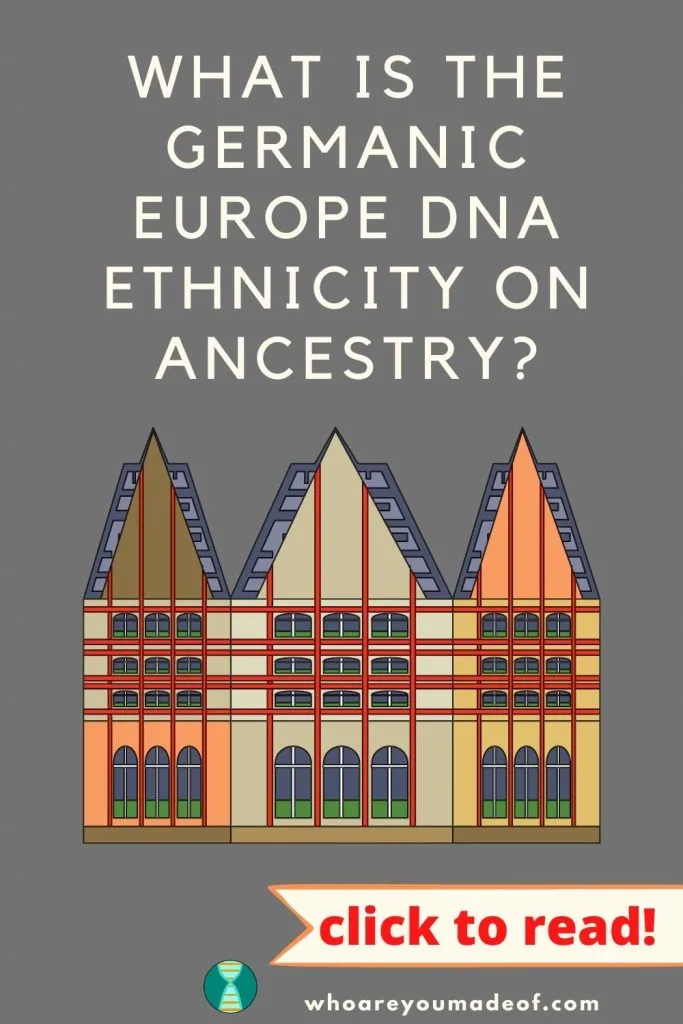
Conclusion
I hope that this post helped you understand a little bit more about your Germanic Europe ancestry, how you might have inherited your Germanic DNA, and how to go about researching your Germanic Europe ancestors.
If you have any questions about something that you read in this post, or would like to add your experience or thoughts about your Germanic Europe DNA region, I'd love to hear from you in the discussion below.
Thanks for stopping by!


Joe
Friday 6th of October 2023
Hello, My Maternal side is mostly Germanic European. These ancestors lived in Hungary but they spoke German. My one Grandfather even identified as a "Magyar"(Hungarian). But my mother does not remember anything but German being spoke in the house. Would this clue mean that they were probably German even though there is a long line of them living in Hungary? Thank you, Joe
Jamie Spinks
Thursday 24th of November 2022
I’ve only briefly read your blog . But there seems no mention of England being part of Germanic Europe. Like most of Western Europe there’s a huge DNA overlap from the UK into the Benelux countries . England is a Germanic country the basis of our language is Germanic , our culture is Germanic .And a considerable amount of our DNA is Germanic thanks to Jutes, Saxons, Angles, Friesians, and various Viking tribes.
Vicki Smith
Saturday 8th of October 2022
I'm black, so how in the world did this pop up in my results?????
Bernice Tinius Walters
Tuesday 9th of August 2022
my brother Walter Edwin Tinius and I both have DNA with Ethnicity inheritance mainly in Eastern Europe and Russia; one parent with 23% Germanic Europe and other parent less G.E. Walter has his Tinius tree open I believe. I read about "haplogroups" in those areas...the Indo European. How do I find out what our Y-DNA haplogroup is--what is the procedure for that research? Does Ancestry have such a specific research department ?--will appreciate your suggestions and any researcher contact to deal with that subject. Thanks in advance. Bernice Tinius Walters (my old EM address -Cable..should be removed)
Bernadette
Sunday 19th of June 2022
This helps explain the mysterious 2 percent Eastern Europe and Russia on my father’s side. An early ancestor (Friedl) came from Germanic Europe. Another 50 percent ethnicity from Eastern Europe and Russia came from my mother’s side. These ancestors were recent and came from Slovakia and Ukraine. I knew it wouldn’t be possible to test out at 52 percent Eastern Europe and Russia from my mother’s side alone.